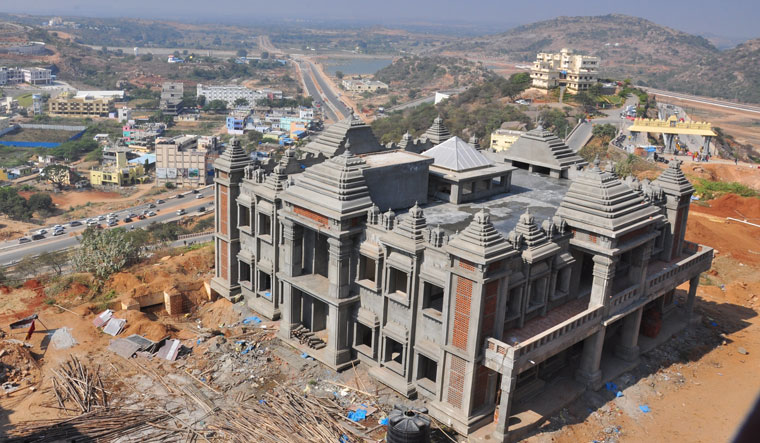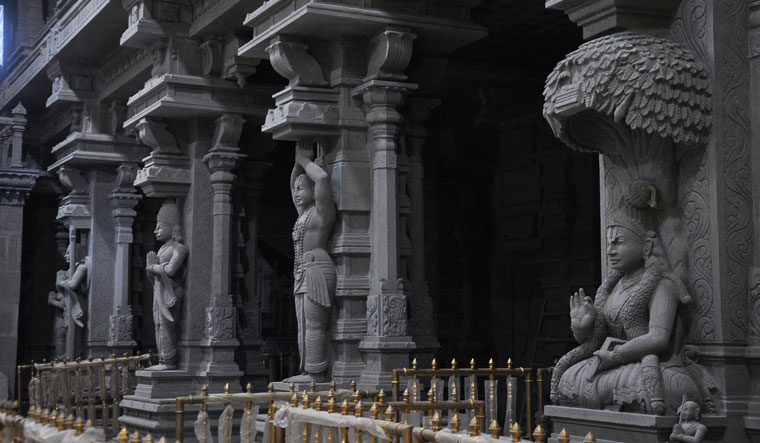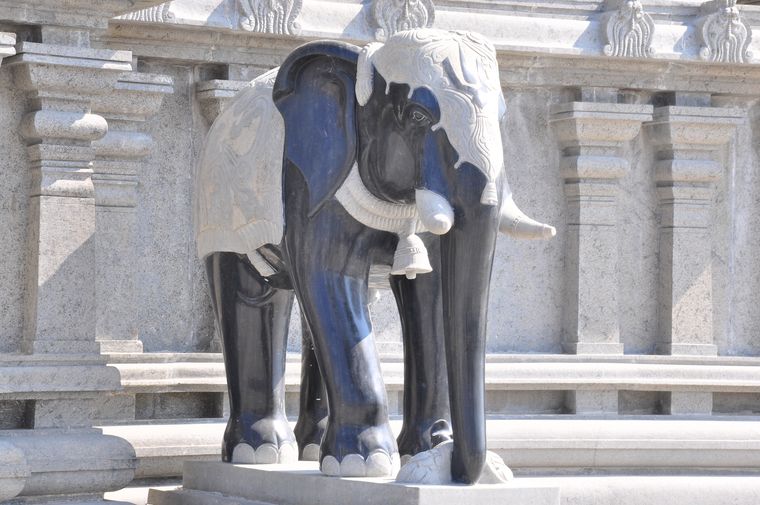Yadagiri is a popular name in Telangana, across castes and classes. So is its female variant, Yadagiriamma. The popularity of the names highlight the widespread devotion to the deities of the Yadadri Lakshmi Narasimha Swamy temple—the Narasimha avatar of Lord Vishnu and his consort, goddess Lakshmi. The temple itself stands on Yadagirigutta; Yadagiri is another name for Narasimha and gutta means hill. The temple town, also known as Yadadri, is about 60km from Hyderabad—and is home to India’s most expensive religious complex project.
In 2015, the Telangana Rashtra Samithi government decided to upgrade the Yadadri temple complex on the lines of the Tirumala temple in Andhra Pradesh. Yadadri Tourism Development Authority (YTDA) was formed to run point on the project, which was expected to cost around Rs2,000 crore. Five years and Rs1,200 crore later, the complex is ready.
Yadagirigutta mirrors the rocky terrain seen across the Deccan plateau. Previously, a narrow road from the highway, flanked by small shops, led to the foot of the hill. From there, ghat roads led to the top. The temple was perched on one corner of the hill. The sanctum sanctorum was a small cave in which stood a stone with engravings of Narasimha. Temple authorities and locals say it has been a pilgrimage site for centuries, visited by thousands of devotees daily.
In 2017, the original site was closed, and work began; a temporary temple was put up for pilgrims. Overseeing the hundreds of sculptors, labourers, engineers and artisans was Kishen Rao, vice chairman of YTDA. The retired IAS officer made his name by executing landmark projects such as the Shilparamam handicrafts exhibition and the promotion of the Chowmahalla Palace as a venue for events.
In Yadadri, his challenges were manifold as he had to raise an “ancient era-styled” temple complex. “We followed architecture from the time of the Kakatiyas,” he said. “Bricks and cement were not used; we got sculptors from Mahabalipuram in Tamil Nadu and from Andhra Pradesh, apart from Telangana.” Black granite, locally known as krishnashila, was brought in from quarries in Guntur district, Andhra Pradesh. Anand Sai, a popular art director in south Indian movies, was roped in to design the temple.
D. Babu Rao, a consultant engineer involved in the project said that a laboratory was set up on Yadagirigutta. “We tested materials on a daily basis,” he said. “We did ultrasonic testing of all the beams to make sure they are defect-proof. The site had loose boulders, so we had to dig up the foundation and use technology for stitching and grouting of rocks. It is difficult terrain.”
The new complex begins with an outer prakaram (courtyard) with entrances from the four cardinal directions. The main entrance is the 22m-high east gate, flanked by two stone elephants. The complex has six gopurams or entrance towers, including two for the inner compound. The most popular motifs in the complex seem to be elephants, lions and flowers. For example, stone lions line the inner prakaram. An engraving of Chief Minister K. Chandrashekar Rao’s likeness was removed after protests erupted.
In the main temple’s hall, there are smaller temples dedicated to lesser deities, like the one dedicated to Lord Hanuman. The pilgrim hall is 33m wide; its walls feature carvings and the arches depict the avatars of Lord Vishnu. Just above the entrance to the sanctum sanctorum is a bronze sculpture depicting the epic tale of Prahlada, the devotee to whom Lord Vishnu first revealed the Narasimha avatar. Elsewhere in the complex there are larger-than-life statues of the 12 alvars—the Tamil poet-saints who revived the bhakti movement with their hymns in praise of Lord Vishnu.
Velu Anandacharyulu, chief architect of the temple, said that this is the only temple in the world to have used krishnashila from the basement to the top. And the mortar was made from an ancient recipe, he added. Anandacharyulu, who holds a PhD in temple architecture, said, “Inknut, jaggery and aloe vera have been used to bind the stone. The (mortar) keeps the indoors cool in summer and warm in winter.”
A senior official associated with the project, who requested anonymity, said: “Lime, jaggery and sand were used for the construction of ancient temples. This mixture would be trampled by buffaloes. Later, jute, jaggery, aloe vera, and burnt and powdered bricks were used. Muslim rulers increasingly used egg whites and ripe bananas.” Around 2,500 tonnes of aloe vera, inknut, jaggery, lime and jute went into the mortar for the Yadadri temple complex.
Each ingredient in the mortar is reportedly chosen for multiple properties. For example, while inknut helps in warding off coughs and promotes immunity, it is adhesive and also helps repels insects that could be attracted to the jaggery. Aloe vera has both herbal and adhesive properties, and jaggery provides strength to the mixture. “We have built the temple to last at least 1,000 years,” said Anandacharyulu. The authorities are expecting 35,000 devotees a day, up three times from the current 10,000. Collections are estimated to go up by 40 per cent.
YTDA has acquired close to 1,900 acres around the temple, including on the surrounding hills, for commercial projects. Temple City, a housing project for devotees, is ready; ring roads around Yadagirigutta are nearing completion. The better roads, green spaces and rejuvenated water bodies have boosted the local real estate business. T. Rambabu, managing director of local real estate firm Vasavi Ventures, said that many residential projects were coming up within a 10km radius of the temple. “Five years ago, a square yard was Rs3,000, but now, it is Rs10,000,” he said. “Prices of plots have jumped from Rs50 lakh per acre to Rs2.5 crore. Software employees and investors form a significant chunk of prospective buyers.” He added that half the farmland in the area had gone commercial because of increased demand.
Politically, the project is important for the chief minister. The BJP gained ground in recent polls and has accused the ruling TRS of minority appeasement. “KCR has said on record that he is a bigger Hindu than anyone else,” said political analyst Telakapalli Ravi. “Others in his party have also said that they do not need RSS as KCR is an ardent follower of Hinduism. He will definitely make it a big religious event and project himself as the champion of Hindus.” Ravi added that he was not sure if Lakshmi Narasimha Swamy could save Rao politically. “These initiatives do not have [a lasting] impact on the minds of the people,” he said.






